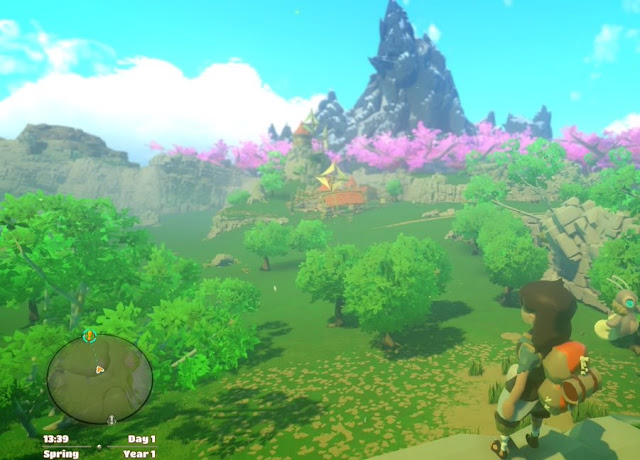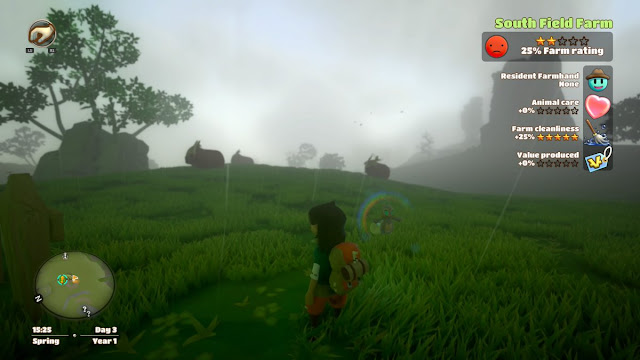Review by Matt S.
Yonder is an antidote to the endless sex, violence, and other “mature themes” that have become so commonplace in videogames that we’ve stopped noticing them at all. And I’m not talking about just the extreme examples here; it takes a game with absolutely no conflict at all to realise how thematically violent a game like The Legend of Zelda: Breath of the Wild is, despite it being a game that we all have perceptions of being completely innocent. It also takes a game like Yonder to realise that we don’t need any of that stuff to have a wonderful experience.
I made that comparison to Zelda: Breath of the Wild only because Yonder generates an eerily similar first impression. Yonder’s use of cel-shaded bold, clean colours to construct the world and give the landscapes a modern impressionistic tone share an aesthetic similarity to Breath of the Wild, as does the first few moments where your hero – male or female (see, Nintendo? It’s not that hard) – emerges from a cave to witness an expansive, primal world that promises adventure and wonder. From that point the two games diverge. Breath of the Wild quickly introduces you to its combat and loot systems, and generally becomes a game. A very fine game, to be sure, but one that sticks closely to conventional expectations of games even as it refines them.
Yonder, meanwhile, hones in on a very different quality; it becomes a tranquil, relaxing open world that you simply explore and derive wonder from as you discover new areas, meet new people, and spot each of the range of ridiculously cute animals for the first time. In many ways it is far more true to the impressionist movement than its (inevitably) far more lauded peer. Impressionism an art movement art that was reactionary against the other artistic norms of the time, and, in an ironic twist, did so in how it portrayed the mundane in the real world. Fast forward to videogames today and combat and loot systems are most certainly not mundane to the real world. However, the antidote, Yonder is mundane. If you were to wander up a hill at a farm to marvel on what’s on the other side, you’ve just done Yonder. In that, the game remains thematically consistent across both its art style and interactivity, and in turn actively resists the dominant game-like elements that are expected from open world adventure titles. It’s different and it’s consistent between theme, art, and gameplay, and that’s an appealing and rare mix in this industry.
Activities in Yonder are rarely more complex than figuring out what kind of food an animal – sorry – an utterly adorable animal, likes, and then using that food to gently coax it back to your farm so you can become lifelong pals with it. At other times you might cut down a tree to collect materials to build a bridge to get to the other side, but the real joy is in getting a seed from almost every tree chopped down, and planting it to grow a tree anew. You’ll come across the odd village and person that needs your help, but “quests,” such as they are, aren’t more than less-than-subtle prods to explore around the world and find areas that you hadn’t previously noticed. Credit must go to the team for the world design here; Yonder might be relatively small by modern open world game standards (it’s still huge), but most open world games aren’t able to make you gasp in wonder every time you crest a hill, because what you see before you is so completely different, and somehow more impressive, each and every time. With most open world games, I get bored of the drudgery of traversing the space, and that boredom comes on quickly. With Yonder, I never once got tired of simply walking around.
Again, the game’s activities are all positively mundane, but that’s it’s heart and soul, and it’s such a gentle soul that it’s impossible to play without feeling warm and comforted as long as the controller’s in your hands. Without combat, you can relax and simply enjoy the world, without the slightest concern that you’ll bump into something you didn’t want to. The closest the game comes to challenge is in having to find little sprites around the world, which lend you magic power that is needed to dissipate ugly, purple fog that blocks you from accessing some areas. Some of these instances of purple fog require more sprites and magical power to remove, but there’s no time pressure on getting rid of them, and if you take your time exploring, as you’re meant to, and you’ll never be short on these sprites when it comes time to get rid of a specific fog instance that you need to to progress the story.
As you can probably guess, there’s a strong narrative around preservation and living in harmony with nature that runs through Yonder. Every time you take from the world, you have the opportunity to replace, and animals and the like are friends to be won over, rather than things to hunt. The purple miasma looks threatening and hostile, and that’s because it’s in conflict with nature; it’s made of unnatural colour, and its chaotic swirling is a stark contrast to the gentle and sedate world around it. Again, there’s no health bars, and no time limits, so this miasma isn’t a “threat” in video game terms, but you’re going to want to remove it anyway. Not just because that’s how you’ll progress through the game, but you’ll also want to rid the world of them because they’re such a blight on the otherwise pristine paradise.
Yonder has a crafting system, and every so often you’ll need to build things to progress further into the world. The materials are readily available and easy to acquire, and the crafting system is never as complex as we see in games like Minecraft and Dragon Quest Builders. For the most part you’ll be crafting things in direct response to missions, and those missions always do a good job of walking you through exactly what materials you’ll need to complete them. I simply see it as impossible that a player could ever get “stuck” in Yonder and not know what to do next. I suspect that many would chalk that up as a flaw, much as they do “walking simulators” and the like, but I have a different view. I see it as the game being thematically true to itself and allowing players the opportunity to continue to experience joy and wonder in exploring new places. This is what the title “Yonder” refers to, after all; the idea that there’s something of note off in the distance. If you had to struggle to get there the game would be focused on the moment-to-moment, rather than the goal.
Yonder is the nicest, and yet most deeply transgressive game we’ve seen in our little section of the art world, for quite some time, if not forever. It appropriates, but actively resists recreating every feature common to its peers, and indeed the entire games industry. At a time where the question of violence in open world games is never actually questioned, Yonder is brave enough to propose an alternative to what we all take for granted. It argues that yes, it’s okay to have a game that’s cheerful, happy, and non-violent. Not even the kind of harmless, bloodless violence of a Zelda game. Yonder is a game that matches is aesthetics, design, and vision in a way that very few games could even hope to achieve; even those games that end up with astronomical Metacritic scores and GOTY awards from every corner. It’s a beautiful, clearly heartfelt masterpiece, and if more games were to follow this one’s lead, I would have a great deal more faith in the emergence of video games as an art form.
– Matt S.
Editor-in-Chief
Find me on Twitter: @digitallydownld
 |
| Please Support Me On Patreon!
|










